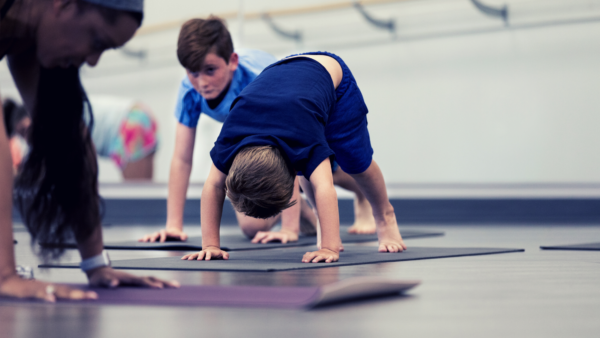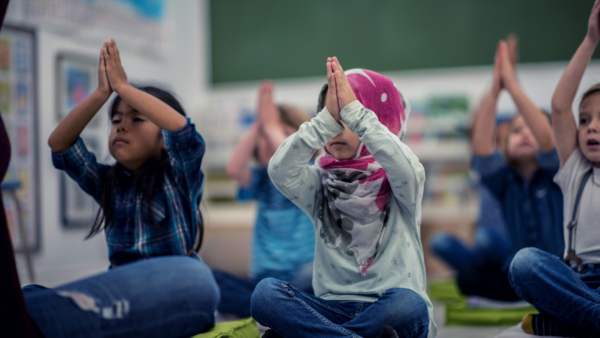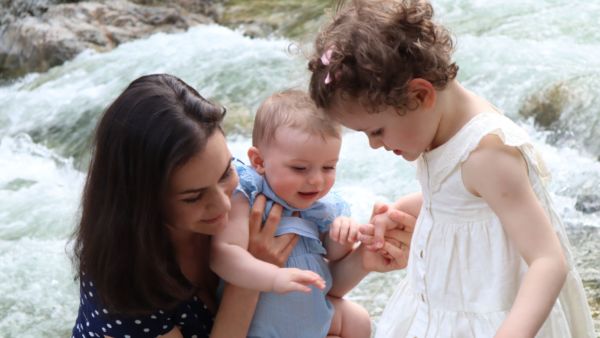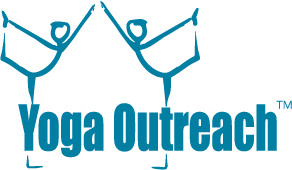Teaching Kids Yoga is a growing niche for yoga teachers. Yoga for kids is a fun physical activity particularly for those that don’t enjoy other types of team-based sports. It’s also popular with parents. They want their children to learn tools that will help them regulate their emotions and cope with anxiety, ADHD, bullying, grief and other tough challenges.
Yoga Outreach is already well-known for supporting adults in recovery from trauma, addictions and mental health challenges. In this article, we’ll tell you why we partnered with Katie Connolly of gloWithin to develop a trauma-informed training for working with kids.

Mindfulness tools at an early age
A common piece of parenting advice is to remember you’re not raising children; you’re raising adults. Think beyond getting kids to behave, and ask what solution or tool would help them cope with similar situations as an adult. There won’t always be a teacher or parent to put a bully in their place, or take over an overwhelming task.
When kids develop awareness and language for difficult emotions like anxiety, fear or anger at a young age, they’re less likely to avoid these feelings as adults. The feelings, though unpleasant, are familiar, and reliably temporary. Kids are confident they can manage anxiety or anger because they’ve practiced throughout childhood. Mindfulness tools are already habits.
Body Mapping Tool Kit
One activity Katie loves to use with kids is called Body Mapping. She asks kids to draw an outline of their body on a piece of paper. Then kids colour in places on their body where they notice sensations around worry, fear, or anger.
“If you notice a pattern of emotions like anxiety or anger in a particular space in your body, you can write a tool next to it that would help release it,” she explains.
Katie adds, “I would always notice emotions around my heart. So I would do back bends to release emotions from that area.”
Kids’ nervous systems are different than adults
A big part of Yoga Outreach Kids Core Training™ will involve exploring the nervous system, and the interaction between sensations, emotions and thoughts. It’s key for parents and teachers to understand how the nervous system works, so that they can recognize the effects of trauma. Katie explains that trauma symptoms show up slightly differently in kids than in adults. For one, while both kids and adults are reluctant to verbalize symptoms, kids may not even have the vocabulary to recognize emotions and sensations.
“When trauma is non-verbalized,” Katie explains, “it becomes stuck in your body. In our younger years, under seven, we are taking it all in because we are always in a theta state – similar to in meditation and also the space in which our body can heal itself.”
What’s a Theta State?
According to The Science of Brainwaves, “Theta waves are strong during internal focus, meditation, prayer, and spiritual awareness. It reflects the state between wakefulness and sleep and relates to the subconscious mind. It is abnormal in awake adults but is perfectly normal in children up to 13 years old. It is also normal during sleep.”
Yoga is one way to process traumatic experiences in a healthy way, with a somatic (body-based) release of emotions.

Highly Sensitive and ADHD
Participants in the Yoga Outreach Kids Core Training™ will also learn ways to offer more support to highly sensitive children, as well as those who have ADHD or autism. Katie was also a highly sensitive child, and suspects she has ADHD based on family history, though she doesn’t have a diagnosis.
Katie says, “It’s a challenge because you’re taking in every detail all the time. But with these tools we can nourish our nervous systems so we function at our best given the world we live in.”
Yoga and mindfulness practices help kids differentiate between what is other people’s energy and what is theirs.
Kids learn differently
Kids learn primarily through play – – kinesthetic and visual. But when Katie Connolly observed mindfulness and yoga classes in school a decade ago, she noticed they were being taught as if to adults.
“I realized I could bring those same tools to children in a more engaging way,” says Katie. “A lot of school curriculums have changed over the last 20 years. They’re so much more progressive now.”

Accessible and Condensed
One advantage of this training for teaching kids yoga is that it’s online via zoom. Thus, people can join from any part of the world, no matter how remote.
It’s also great for parents, because they can take the course without leaving home. In fact, Katie highly recommends this course for parents.
Since the course is condensed into 20 classroom hours (group and personal work), it’s also ideal for social workers, and mental healthcare professionals. They may not be interested in earning a full yoga teaching certification, but want to know enough to share yoga with the children they work with.
Those who already have a 200-hour teaching certificate can use this relatively short training to easily add a specialization to their skillset. Since Katie is a Yoga Alliance Continuing Education Practitioner, students who complete all the coursework will qualify for Yoga Alliance continuing education credits.
Teaching Kids Yoga
As parents, teachers and even employers (those kids grow up eventually!) begin to see the value of emotional regulation, it’s likely that opportunities for teaching kids yoga will grow. It’s important that the teachers who move into these roles understand the nervous system and how trauma affects it – specifically in children. And just as important – parents and teachers need to know how to make these tools fun and engaging to learn.

